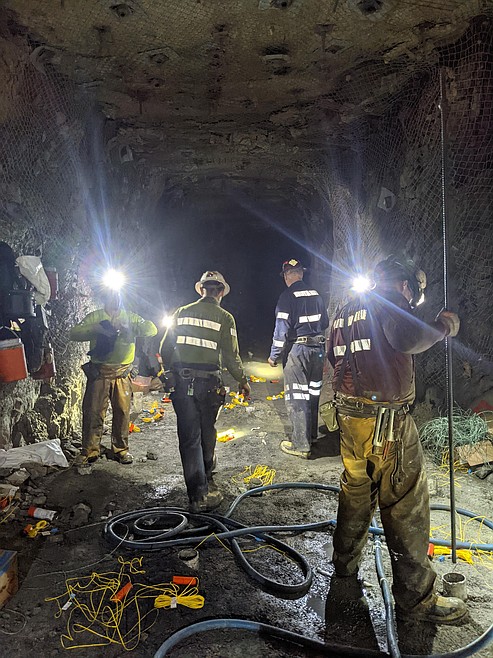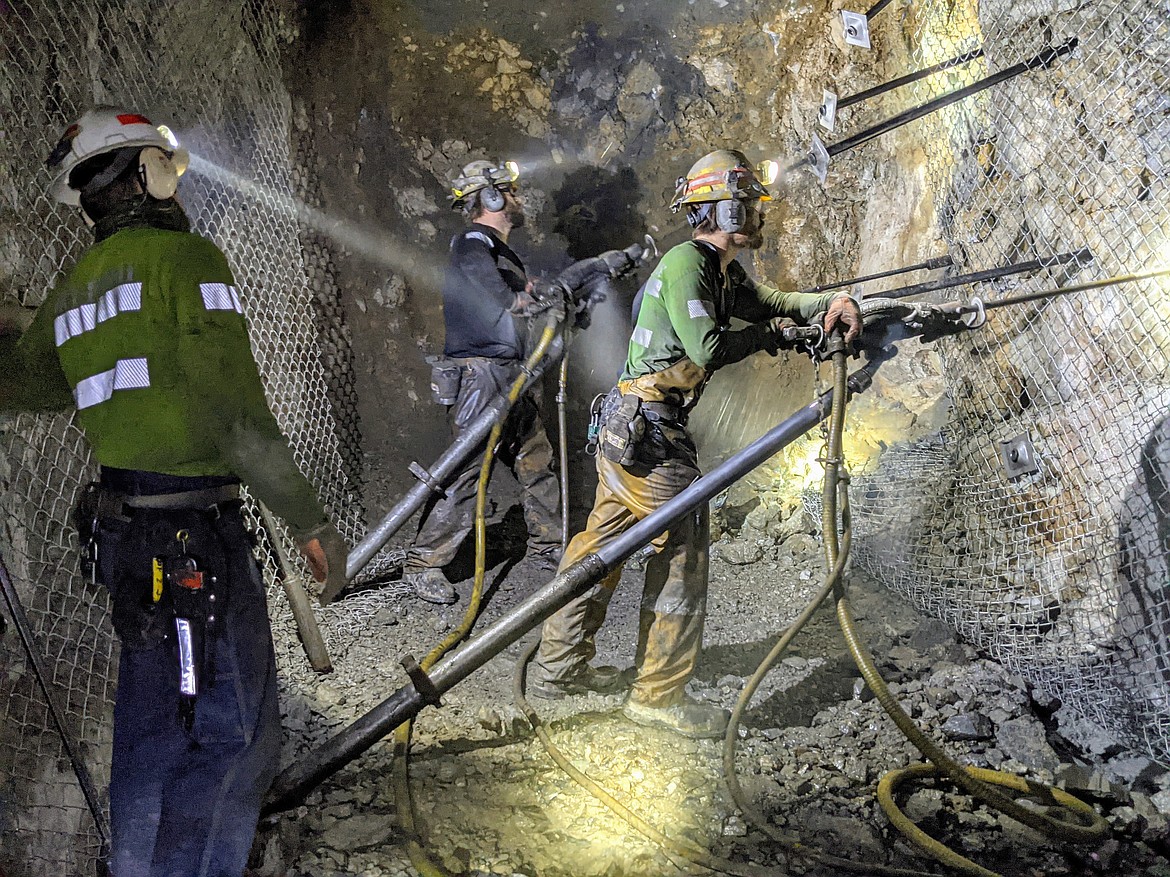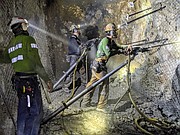My first time really underground — The Lucky Friday Mine
I've experienced extreme heights my entire life. From visiting some of the tallest peaks and buildings in the Pacific Northwest to having frequent flyer status by the time I was able to read — having an irrational fear of heights has never been an issue for me. An irrational fear of being in a tight space over a mile below the surface though? That's a different story.
So it gave me pause about a month or so ago when Luke Russel, Hecla Mining Company's vice president of External Affairs, offered me an underground tour of the Lucky Friday Mine in Mullan. While I have written extensively about the mine in the time that I have been at the News-Press, I had never once gone down into it (or any other active mine for that matter).
As a North Idaho boy though, I felt it necessary to go so that I could check it off the "things panhandle natives should do" list that I have going in my head.
When I first got to the complex earlier this month, my mind was relatively put at ease when I met up with Lucky Friday acting Health, Safety and Environmental Manager Lance Boylan, who was tasked with making sure I didn't hurt myself during the tour.
The safety measures and protocols were numerous, but not overwhelming. By the end of the briefing Boylan gave me, I felt like I had a solid understanding of what I was supposed to do in most worst case scenarios. I was even encouraged to point out anything I saw along the way that may be a hazard.
After getting decked out in my safety equipment, we made our way down to the 5900 level of the mine via the Silver Shaft hoist. First-timers should be aware that you aren't going to be stepping into an elevator you'd find at a Red Lion or Marriott Hotel. This impressive piece of machinery is responsible for not only bringing miners up and down, but heavy equipment as well. As such, the cages are simple steel boxes that are made to take a beating.
The ride down may have been the most unnerving part of the entire tour and even that wasn't too bad. Visible only because of your headlamp, seeing the solid rock and various other levels fly by as you descend in relative darkness was a bit off-putting at first. After a few moments though, you adjust to the jostling of the cage and get your bearings.
Upon arrival at the 5900 level, I got my first real look at what things are like in the mine. My assumptions and preconceived notions were immediately washed away as I looked around at what could best be described as an intricate car tunnel.
The Lucky Friday is nothing like how mines are normally portrayed in movies. No cramped spaces, no rickety support beams, nothing like that — not even close. Instead of those mine stereotypes, I was greeted by expansive corridors that were lit in many cases. A mechanic shop just to the right of the hoist entrance/exit could be compared in size to a high school gymnasium.
Boylan and I were quickly picked up by Mine Superintendent Chris Neville, who whisked us off in a UTV to a break room for miners on that level. Even though there are some two-lane roads down there, traffic on one-lane roads is usually organized by the use of a simple light system. A driver pulls a hanging rope which then activates a light at the opposite end of the road — notifying others that there is oncoming traffic.
It was in the break room, complete with Wi-Fi and kitchen appliances, that Neville broke down what the miners were doing and where we would go that day.
Currently at the Lucky Friday, miners are extracting silver ore along with lead and zinc as byproducts from four main veins. Silver concentrate is then taken from the mine's mill and is shipped to Trail, British Columbia, for smelting.
While a few areas are still using a more traditional method of collecting the ore, Neville explains that a new, safer tactic is being tested in some of the deepest parts of the mine. One of these areas in particular was where we went next, below 6,000 feet.
This experimental method, currently referred to as underhand closed bench, has miners blasting the entire length and width of the stope strike for two vertical cuts. Traditionally, ore extraction is performed by blasting 8-foot horizontal rounds by the width of the vein in a single, 10-foot vertical slice. The traditional small extraction blasts slowly build stored energy that could create rock bursts at unanticipated times.
Rock bursts are spontaneous, sometimes violent failures of rock that can occur in high-stress mines, such as the Lucky Friday.
Boylan explained that while this new method being tested isn't necessarily slower or faster than the traditional method, it is potentially much safer.
"It de-stresses the strike length," he said. "When you talk about rock bursts, that happens when you have an uncontrolled release of energy. Everything is under pressure. We have 5,900 plus feet of rock above us — that's a lot of weight. So, when that stress builds, you get the potential for a burst. In an effort to control that by blasting all at once, we may be able to dictate when the bursts happen so no one is in there when it happens.”
Another mining method involving a machine called the Remote Vein Miner is also on the table, but the machine has yet to be delivered to the mine.
The RVM is described as a state-of-art rock cutting machine that is designed to consolidate the multiple mining processes into a single, continuous operation.
Currently, the mining sequence includes drilling and blasting rock, loading or mucking that rock into trucks, then hauling it to the hoist to take to the surface. That process is followed up with bolting the ground to ensure stability and then repeating the process.
“The RVM could operate manually or remotely and could do most all of that in a single, continuous operation,” Russell said in a previous interview. "The RVM represents a big change in how mining may be done at the Lucky Friday."
Our stops along the tour included the 6350 — 12 stope, 640 — 32 slot, 6500 — No. 4 shaft station area, 6580 — No. 4 shaft loading pocket, and 6450 — 16 stope. Hecla explains that the No. 4 Shaft reaches 9,600 feet below the surface and is an important part of Lucky Friday’s future as it provides access to the highest-grade ore in the mine’s 75-year history and should extend the mine’s life for 20-30 more years.
Throughout all of these stops, the environmental factor that took the most getting used to was the wild fluctuation in temperatures. Without proper ventilation, underground temperatures can go well over 100 degrees. Even with the ventilation, the temperature can still hover in the low-to-mid 90s.
The many miners of the Lucky Friday seem to have acclimated to all the conditions though. For a place over a mile underground, it certainly is bustling with activity. As we drove from place to place, there always seemed to be someone doing something. From miners bolting in the 6350 — 12 stope to setting emulsion explosives in the 6450 — 16 stope, there was never a true feeling that you were far from some sort of work being conducted.
This makes sense, considering that the Lucky Friday produced 179,000 tons of ore in 2020 and plans on roughly doubling that number in 2021.
It was also clear that safety was always at the forefront of everyone's minds. On top of the normal equipment and precautions taken for general mine safety, miners were also abiding by new COVID-19 regulations, such as mask wearing and limiting the number of people in certain areas.
Hecla's commitment to safety could really be seen roughly a week after my tour when a freak windstorm knocked out power to the Silver Valley and the Lucky Friday.
"This resulted in one of the longest multi-day power outages experienced in the region for years," Russel said. "Yet, the Lucky Friday Mine’s previous investment in a backup power system allowed all workers to be safely evacuated from the mine."
Overall, I enjoyed my experience below the surface. After writing about the place for so long, it was nice to be able to finally put some images to the words. A huge thanks to Hecla Mining Company, Luke Russell, Lance Boylan and Chris Neville for making everything happen.



